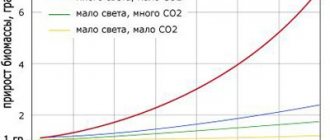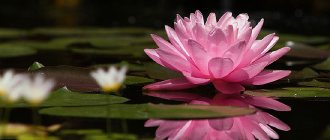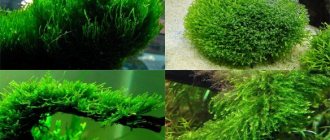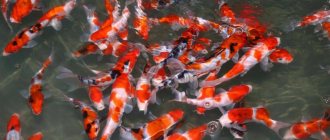Keeping koi carp in a pond
In captivity, Japanese koi can live quite a long time, ranging from 25 to 35 years.
Koi carp can grow up to 130 centimeters in length, which is typical for some breeds that are genetically closer to their ancestor, the wild carp. But usually their length does not exceed 90-100 centimeters.
With that said, it is of course better to keep koi in a pond rather than an aquarium.
The pond can be built on a concrete base and soft waterproofing. The latter uses synthetic rubber (EPDM). With its help you can create ponds of any shape and size. If there are sharp stones in the ground, then it is also necessary to use fleece (a special backing), which will prevent damage to the EPDM film used. A pond with a concrete base is more expensive, but also the most durable. A concrete pond allows you to create steep vertical banks, which saves space while increasing the water volume of the pond. Forum about keeping fish in a pond here.
In addition, we would like to draw your attention to the products of the famous Dennerle brand, which are intended for ponds; read more about them here .
Do-it-yourself pond in the home garden #1
#2
#3
#4
#5
#6
Recommended minimum pond sizes:
— depth from 1.4 m.
— volume 8 tons (3m x 2.46m x 1.23m).
It should be remembered that these brocade koi are quite active fish, they need to swim, and accordingly they need a spacious pond. Naturally, there is no specific data on how deep and volume the pond should be, since it all depends on how many koi carps you want to put in the pond.
Recommendations for the location of the pond: a quiet, calm corner of the garden (as far as possible from noisy places, such as roads), but close to the house (so that you can admire the koi in any weather without leaving the house). The sun's rays should illuminate the pond all day.
During melting snow or rain, water from the adjacent areas should not flow into the pond. To do this, a storm drainage is built around the pond or the pond is created elevated.
It is important to equip the pond with a powerful two-stage filtration system: biological and mechanical. It must guarantee the effective removal of fish waste products and nitrogen cycle products: ammonia, nitrite and nitrate from the water, and also maintain normal gas conditions.
In a flowing, large pond with aquatic plants, in principle, the filtration system can not be used. But there is a chance that koi will begin to eat underwater vegetation or dig in the ground in search of food. Therefore, the optimal options for setting up a filtration system are: build an additional regeneration pond with aquatic plants or create a bioplato - a stream or small pond, entirely covered with pebbles with aquatic plants planted in it, through which water will circulate from the pond.
Most of the factors that affect biological balance depend on the volume of the pond: the amount of dissolved oxygen, temperature conditions. Thus, the larger the pond, the easier it is to maintain biological balance.
Equipment
Carps are not picky about their conditions, but despite this, if they do not live in a large open body of water, they will need to acquire some equipment that will help maintain good water quality.
Filter
Without such a device, even with regular cleaning, the water will quickly become cloudy and you will not be able to enjoy watching your pets. You need to purchase a unit with a large filter fraction, as it clogs more slowly. Ideally, 2-3 powerful devices should be installed in a pond. Pets have a high metabolism, and they produce a large amount of waste that must be removed in a timely manner. The filter should be washed when its performance drops. Without filtration, the purity of the contents of the reservoir is impossible.
Sterilization
Some carp breeders see the need for a disinfection device that treats the pond with ultraviolet light. However, without such a device, there is a danger that diseases will arise. Given this, you should not skimp on a sterilizer, which also helps maintain water clarity, which is important for fully enjoying your pets. In order for fish to live longer, a device will also be required.
Aeration
Insufficient oxygen content in water is tolerated by fish quite well and does not pose a danger to them. If there is filtration in the reservoir in which pets are kept, they will be able to survive without aeration. However, to compensate for oxygen deprivation, they will constantly greedily swallow air through their mouths on the surface, which looks extremely unpleasant. A lack of oxygen does not make the appearance of a pond with fish any better, and therefore you should not abandon the compressor.
Backlight
Lighting plays an important role when creating a pond with fish. In dim light, the color of fish from the Cyprinidae family fades, and they lose their beauty. Optimal lighting is bright sunlight. When it is not enough, the carp habitat must be additionally illuminated, for which metal halide lamps are purchased. They provide light as close to natural as possible. There is no need to leave lighting on 24/7. At night, fish, like their owners, sleep, and light only disturbs them. Koi sleep at the bottom, lying on their sides. To maintain the brightness of the color of fish, daylight hours are required for 12-14 hours.
Keeping koi carp in an aquarium
We think that there is no need to dwell on the fact that an aquarium for keeping koi carps should be large, from 500 liters, or better yet, a ton or two. Of course, these figures may shock a novice aquarist, but for pros and aquarium fans these figures are not so prohibitive. We have all seen aquariums with American or African cichlids from 1000 liters. and more. And this is no longer a luxury, but rather ordinary things.
Water parameters for keeping koi carp: total hardness 4–10 GH, carbonate hardness 1–7 KH, nitrogen compounds should be at zero: NH4 0, NO2 0, NO3 permissible up to 40. In general, every conscious aquarist should always have a set of drip tanks on hand tests, at least for nitrate and phosphate. Fortunately, they have now become inexpensive, there are no problems with their assortment and acquisition. For example, we can with a clear conscience recommend you the cool UHE drop tests, , but they are sold only online. In stores in your city - offline, you can find inexpensive Vladox tests . Friends, watch out for nitrogen compounds, keep them in check and everything will be fine for you and your pets.
The water temperature at which koi feel comfortable is 15–30 C; carp are able to tolerate temperature deviations ranging from 2 to 35 C. But at the same time, their immune system “turns off”. The optimal pH level is 7.0–7.5 (neutral). The O2 level in the water should be 4–5 mg/l, but fish can tolerate a lower level – up to 0.5 mg/l.
The most important thing in keeping koi in an aquarium is ensuring proper filtration. This can be achieved by installing two filters working on biology and mechanics, as well as by means of phytofiltration . It is possible to use preparations that remove phosphates and nitrogen, for example, Tetra EasyBalance .
The soil in the aquarium should consist of fine or medium sand. The aquarium itself is decorated to your taste, but without any frills, because... fish will constantly rummage and rearrange the decor at their discretion.
From the above, we can conclude that koi carps, although beautiful, are sold everywhere in pet stores, but, alas, they are not for a beginner. This fish is for an experienced aquarist and it is advisable that this aquarist has a house in the village
By the way, often beginners in the aquarium hobby, due to a certain similarity with goldfish, identify koi caps with them. However, this is not so, they have one family - carp. But the gender is different. Koi - genus Cyprinus (carp), goldfish - genus Carassius (crucian carp).
What size pond is needed?
The volume of a reservoir is important for fish, since only if it is sufficient can they fully grow and reach a size that allows them to reproduce. Ornamental koi carp are large in size, and a standard home aquarium is unsuitable for them.
The volume of an aquarium or pond is calculated according to the following scheme: 5 liters per 1 cm2 of the fish’s body. This shows how large a pond is required for fish. They are not suitable for standard maintenance in an apartment, but in the winter garden they can be used to create a pond that meets the requirements.
If you place fish in a home aquarium, they will be able to live for a long time (although not to old age), but they will never acquire all their beauty and will not delight the owner with their splendor. In essence, these will be runts frozen in the state of a teenager. To understand how much the owner loses by raising carp in a small aquarium, just look at a well-grown ten-year-old specimen. When it is not possible to place fish in a reservoir of the required size, you should refuse to buy them. Although pets live in a small container for some time, such keeping is cruelty towards them.
Types of koi carp
Koi carp come in a wide variety of colors, the main ones being: white, black, red, yellow, blue and cream. There are more than 80 breeds of koi. For convenience, they are divided into 16 groups, united by one or more common characteristics. The most popular Koi breed is the Gosanke, which includes the Kohaku, Taisho Sanshoku and Showa Sanshoku varieties.
Kohaku is a white carp with distinct red or red-orange spots on its back.
Taisho sanshoku, or sanke, is a white carp with red and black spots. Named after Emperor Taisho.
Showa sanshoku, or showa, is a black carp with red and white spots. Named after Emperor Showa.
Tancho - koi of any color with a red spot on the head. "Tancho" can be called either tancho showa or tancho sanke, or tancho goshiki.
Asagi are koi with blue scales on the back and red (red-orange) scales on the sides.
Shusui is a kind of extended version of the asagi variety: the back of the carp is blue, and there are red (red-orange) spots on the sides.
Bekko is a white, red or yellow carp with black spots.
Utsurimono is a black koi with red, yellow or white markings.
Goshiki is a predominantly black koi with red, white, brown and blue markings.
Ogon is a solid colored koi, the most common colors being red, orange, grey, yellow and light yellow.
Kinginrin (Kinrin/ginrin, kinrin/ginrin) – koi with sparkling golden (ginrin) or silver (kinrin) scales.
Kawarimono, or kawarigoi, are various koi that cannot be classified into any of the identified varieties.
Doitsu-goi are German carp that have no scales at all or have several rows of scales, like mirror carp.
Koromo is a white koi covered with neat black and red spots.
Hikari-moyomono is a koi with a metallic sheen and a combined golden-silver color.
Ghost koi is a “hybrid” of ogon and wild carp. Not a nishikigoi.
Veiled koi (dragon carp; butterfly koi) – koi of all listed species with a longer body. Not a nishikigoi.
Classification
Koi are classified by color. Taking into account the numerous subspecies of fish, 60 directions are distinguished. All species and subspecies are reduced to 16 groups, the names of which were in Japanese and remain so. When breeding and keeping carp, Japanese terms are more often used, which have taken root in all countries. The breeds of koi carp are named as follows:
- Kumonryu
- Kohaku
- Doitsu goyim
- Taisho Sanshoku
- Gosicki
- Showa Sanshoku
- Hikari-moyomono
- Bakko
- Ogon
- Utsurimono
- Kinginrin
- Tancho
- Koromo
- Asagi
- Shusui
Having decided to purchase fish and contacting the club, a beginner will get acquainted with the groups and decide which of them will be the best option for him. When you need aquarium carp fish, you need to consider pets such as veiltails and the like. Such aquarium carps live in containers of 150 liters or more.
Feeding Koi Carp
Feeding koi, like any aquarium fish, should be correct, balanced, and varied. This fundamental rule is the key to successful fish keeping. Let us draw the readers' attention to the extensive line of Tetra products for ponds . Good proven food!
It should be noted that when purchasing any dry food, you should pay attention to the date of its manufacture and shelf life, try not to buy food in bulk, and also store the food in a closed state - this will help to avoid the development of pathogenic flora in it.
Diseases
Their immunity is high, and they rarely get sick. More often, diseases appear due to poor maintenance. The owner may encounter the following problems with his pets:
- costiosis
- ichthyophthyriosis
- fungal infections (secondary)
- helminthic lesions
- fluke lesions
In order to prevent diseases, it is necessary to keep the pond clean, and introduce new inhabitants only after they have been in quarantine for 10 days.
Breeding Koi Carp
Let’s say right away that this is virtually impossible at home. This requires large aquarium volumes.
It is impossible to determine the sex of koi carp until they reach sexual maturity. Sexual dimorphism manifests itself at spawning age when fish reach a length of approximately 23 cm. But sometimes even adult individuals have difficulty determining sex.
The main signs of sex difference in koi carp . Males have sharper and visually larger pectoral fins relative to the body; females have a heavier body, which is associated with the need for nutrients for the normal functioning of eggs. During the mating season, male koi, like goldfish, develop tubercles .
Carp living in a pond will spawn in late spring or early summer, that is, when the temperature rises. The ideal temperature for spawning is 20 C.
If there are a lot of koi in the pond, then you can observe mass spawning. This spawning produces healthy offspring, but many aquarists avoid it because these fry are usually much paler in color than their parents. Typically, breeders select a couple of spawners and place them in a separate spawning pond. The spawning pond does not have to be stationary - it can be a children’s pool, a rubber pool, or similar ponds. During the spawning period, make frequent water changes and feed the fish abundantly with protein and live food.
To obtain a larger number of offspring, producers are removed after spawning, because parents are able to eat eggs and fry. A pond with fry requires good aeration, otherwise they will not survive. A week later, fry emerge from the eggs, which immediately attach to the edges of the pond and hang there for 2-3 days. After the fry of the carp, the koi begin to swim freely. From this moment the fry need to start feeding.
This concludes the article and finally let’s say that in Japan these priceless fish are inherited as jewelry and property. You can buy a fry of koi carp for 50 rubles, and the most expensive koi carp was once sold for 50,000 US dollars.
Description
Chinese colored carps are the result of long-term selection. For this reason, the requirements for the external data of fish are high, in contrast to natural forms. Breeders who breed Koi professionally are sensitive to their appearance and evaluate the following indicators:
- body proportions
- color
- dimensions
- weight
If the fish deviates from the standards, it is not allowed into breeding.
The head of the fish is blunt-nosed, large, and wide. In the female it is wider due to the so-called cheeks. The male's head is graceful.
The body of a fish, tapering towards the tail. The shoulders are broad and the transition to the tail is subtle and graceful. The tail section is strong, allowing it to maneuver well in the water.
The fins of pets are strong, allowing them to swim easily even in the flow of water. The dorsal fin is low and proportional to the length of the body.
The sizes of pets vary depending on the conditions of detention. When the fish live in a home aquarium (with a volume of at least 400 liters), they grow up to 20 cm. When the fish are kept in an open large reservoir, their length reaches 90 cm, and their weight reaches 6 kg.
The character of koi carp is pleasant and friendly. Unlike other fish, they are intelligent and easy to train. They teach pets to eat from their hands, which especially pleases children.
The color of the fish deserves attention. Its colors are different, but always rich. Fish with an even body color that do not have transitions from tone to tone are valuable. There are species that have intricate patterns of spots on the back, head and sides. Striped fish have also been bred. The basic colors of all carp, both plain and patterned, are as follows:
- gold
- red
- blue
- white
- yellow
- bodily
Raspberry-colored brocade carp are rare. Carp breeders owe the variety of colors to breeders who spent years doing complex and painstaking work before they managed to create individuals with persistent traits.
How fast it grows
Carp fish species are in great demand in the market. Large specimens are most in demand among buyers. The optimal weight of carp is from 1.2 to 1.7 kg. For a fish to gain such mass, it will need to be raised for 3 years!
Its growth rate is:
- In the first summer, the fry reaches a weight of 25-30 g,
- During the second summer season, its mass increases by about 200 more,
- In the third summer, their weight increases by approximately 1 kg.
Where is the talisman placed according to Feng Shui?
You can place carp in almost any sector of Bagua, but the head of the fish should be facing the center of the home. In each zone, the magical image will have a special impact on the life of its owner:
- in the knowledge zone (northeast) you can place a single koi figurine or use the image of 2 carp jumping through the dragon gate;
- the southeast (wealth sector) serves to attract wealth, and it is better to place a single fish there;
- the zones of the southwest (love) and east (family) are suitable for a souvenir with a pair of lovers;
- north is the career zone, which is governed by the element of water, and the dragon-headed carp in this place will be especially strong and will bring good luck in achieving your goals;
- the west (creativity) and north-west (patrons and travel) are also favorable for placing a carp figurine and can enhance its influence on the life of the owner of the talisman, but in this case it is worth choosing a metal or metallic-painted figurine.
Koi talismans cannot be placed only in the southern sector, ruled by the element of fire. The sector is in charge of a person’s reputation, and with strong influence from it, it can suffer. If the energy of fire turns out to be stronger, then the tai figurine, installed in the sector for the purpose of strengthening the reputation or for some other reason, will remain a simple figurine. In the worst case, it will work in the opposite direction and lead to the destruction of your reputation.
Compatibility
It is not necessary to keep carp exclusively in a species-specific reservoir. Due to their peaceful nature, koi carps in the pond get along well with other fish. Their neighbors may be:
- goldfish
- catfish (large)
- platies
- trout
- minnows
Small fish, as well as gouramis and angelfish, are not suitable for proximity. Having reached a certain size, carp will easily swallow them, even if they have lived with them since childhood.
Keeping koi carp in a pond with other calm, large fish is not difficult.










